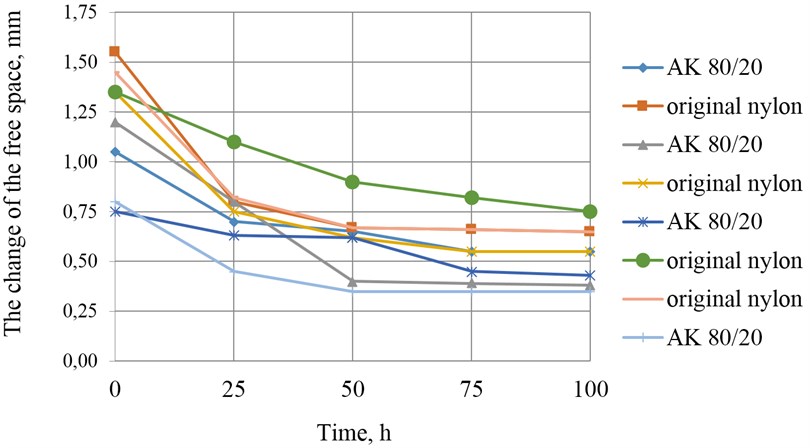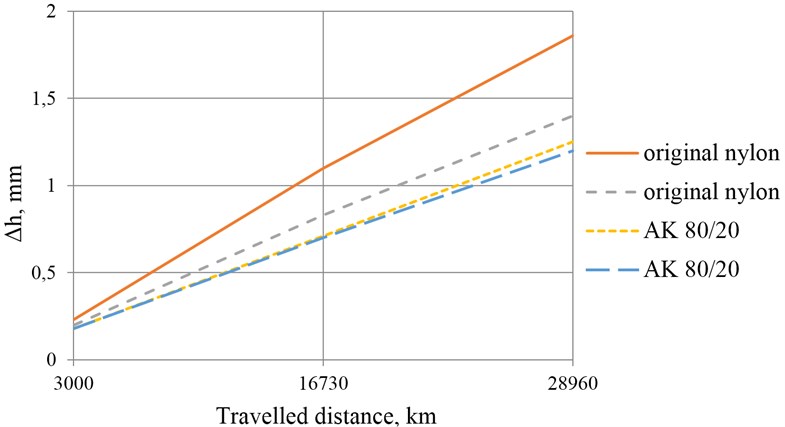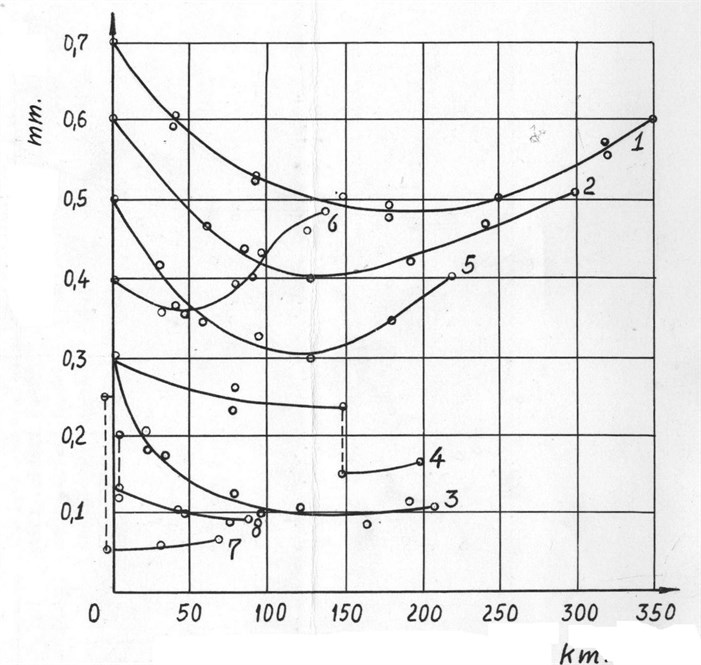Abstract
This article contains the material on the research of polyamide slide bearings aiming to use them wider in agricultural machinery. The brief analysis of polymeric materials is provided in order to find out which of them is more suitable for the production of sliding bearings. The laboratory injection molding machine of the polyamide slide bearings was designed and manufactured by pressure to carry out the research, also a stand for slide bearings laboratory testing and other equipment were produced. They are not included in this article. After some bearings’ laboratory tests, they were tested under operating conditions. Detailed tests were carried out determining the smallest space in the slip knot between the inner bearing diameter and the shaft. The observed phenomenon that after inserting the bushing into its housing, within a period of 72 hours, the inner diameter decreases and stabilizes was taken into account. The long-term bearings research was carried out in aggressive environments (dust, water, oil). As a result, conclusions can be drawn about the wider usage of them in agricultural machiney. The long-term bearings research in grass harvesting machinery was carried out (duration – 6 months) in order to investigate the appropriateness of the choice of materials for the production of bearings, as well as the lubrication regime and their operational reliability. While performing operating tests after treating the material, recommendations for a wider use of polymeric bearings, which are presented at the end of the article, were prepared.
1. Introduction
In modern agricultural machinery the largest part of knots and mechanisms are compiled by friction knots which affect machinery running reliability and other essential exploitation indicators. In most cases, the friction knots are installed with various designs of rolling bearings as well as sliding bushings made of steel, cast-iron or non-ferrous metals. Such choice is often technically difficult, expensive and not always adequate for the design of slip knots. In fact polymeric materials are used in slip knots too. Their use reduces the cost of machinery manufacturing, and facilitates the operational service and some of the other indicators. However it can be concluded that the design and manufacture of slip knots with polymeric materials is achieved by realizing only a small portion of all the options.
The purpose of this article, episodically looking at the polymeric materials – polyamide structural composition, is the selection of comparative testing materials to provide the most relevant results of the carried out tests, at the same time highlighting some of the possible improvements of friction knots in agricultural machines.
Polyamides are hetero-chain poly molecular polymers with the main chain amide groups (-NH-CO-), as well as the methylene groups (-CH2-) repeated 2 to 4 times. A general polyamide formula is NH-CO-(CH2) m-NH-CO-(CH2) n ... .
The individual macromolecular chains are formed so that between the CO and NH2 groups depending to different chains there appears a hydrogen bond that increases strength, chemical stability and anti-friction properties. The more methylene groups of elementary polyamide chain, the higher the water resistance, elastic, resistance to cold and stable physical-mechanical properties, as well as electro insulating properties. Although the melting temperature and strength are lower.
Polyamides is the crystallization of polymers. The relationship between the crystalline and amorphous phases of polyamides depends on processing conditions changing in 40 to 80 percentage range.
Polyamides are suitable for the production of sliding bushings, moreover, their technological harvesting (including casting) allows to impose sanctions. They are currently known functioning as sonication, radiation and vibration. The effect of electromagnetic fields to liquid polyamide when molding can be mentioned as one of the most promising phenomena.
According to factory recommendations, polyamide bearings can handle the pressure of the shaft rotation bearing to 5 N/mm2, slip speed – 0.5 m/sec.
The choice for sliding bushings manufacturing is: copolymer AK 80/20, and the original nylon.
The physical-mechanical properties of copolymer AK80/20 are the following:
- Operating temperature – 70 ÷ (–60) oC;
- Tensile strength limit – 60 MPa;
- Bending strength limit – 40 MPa;
- Friction coefficient – 0.22 (not loaded);
- Melting temperature – 212 oC.
The aim of the research: the comparative performance test of cast pressed polyamide slide bearings mounted in various agricultural machines.
Therefore:
- The laboratory injection molding machine of the polyamide slide bearings was designed and manufactured;
- The slide bearings laboratory testing machine was designed and manufactured;
- The machines in which the polyamide sliding bushing performance testings will be carried out were chosen, the full testing technological scheme was also prepared for the following studies:
• the change of the slip knot free space between the sliding bushing and the shaft depending on the tightness size and stabilization period;
• the research of polyamide slide bearings wear in aggressive environments and variable load conditions;
• the rsearch of polyamide bearings working in grass harvesting machinery;
• the performance of comparative operational tests, generalization of the results, preparation of conclusions and recommendations.
Relevance of the research: on the ground of an exploitation test results, conclusions and recommendations were obtained. Thus there appears an opportunity for a wider use of slide bearings in agricultural machines.
2. The change of the slip knot free space between the sliding bushing and the shaft depending on the tightness size and stabilization period
Designing a slip knot depending on various factors, such as geometrical parameters of the bushing and bearing, material tension properties, water absorption and thermal expansion coefficient, the bushing diameter is expected greater than the diameter of the outlet by the size of tightness. It has been noticed that the pressing inner diameter of the bushing decreases over time. The decreasing time is the time of the inner diameter stabilization.
72 metal rings were made to carry out the experiments. The rings were divided into 12 groups of 6 rings with an internal diameter change of 0.1 mm. After pressing the rings with the constant outer diameter polyamide bushings, the slip knots with 12 different tightness sizes turned out. The inner diameter of the bushing decreases because of tightness sliding. The change of the free space between the inner surface of the sliding bushing and the shaft according to the time is shown in the graph (Fig. 1). The graph shows that the press force is decreasing over time. Based on the test data, the tightness size after 70 hours of stabilization stays unchanged.
Fig. 1The change of the free space between the inner surface of the sliding bushing and the shaft according to the time

Note – under the exploitable conditions, not having in mind the time of stabilization after pressing in the bushing, the inner diameter of the bushing might be decreased to a dangerous level through a small free space. The shaft stucks inside the bushing and the knot becomes unserviceable.
3. The research of polyamide slide bearings wear in aggressive environments and variable load conditions
The majority of slip knots of agricultural machinery work in aggressive environments (dust, water, oil) and variable load conditions. The Russian motor vehicle’s GAZ-53 spring sliding bushes made of bronze and steel work in such an environment too. If we change those bushes to polyamide ones, the test data could be used in the design of slip knots of agricultural machinery.
Fig. 2The size of the abrasion of bushings according to the travelled distance

The pilot bushing working conditions:
- potential maximum relative load of spring sliding bushes of 10 N/mm2;
- the maximum slip velocity 0.3 m/sec.
There were 48 units of bushings replaced in three machines. The bushings have been both lubricated and dry. Their abrasion was measured at regular intervals according to the travelled distance. The test data is shown in the graph (Fig. 2).
Received data:
- comparative pressure 23 N/mm2, 4 N/mm2;
- slip velocity 0.045 m/sec (at the speed of 50 km/h);
- run trying 28960 km, , abrasion 1.2 mm after 30000 km, glissaded way in bushings – 920 km (AK 80/20).
Conclusion: the working period of an agricultural machine at the same PV factor would be about 3-4 working seasons.
4. The research of polyamide bearings working in grass harvesting machinery
The slide bearings made of polyamide resin AK80/20 and original nylon have been tested in Russian grass harvesting machines KIK-1.4. The abrasion rate was recorded on and axes separately depending on the work duration, the comparative load at the surfaces of friction as well as on the conditions of lubrication. The rates of abration, the duration of service and exploitation reliability both of the slip knots and the machine itself were being recorded. On the basis of the tests, conclusions about the appropriateness of the use of such bearings were being made.
Fig. 3Data from slide bearings tests

The studies have found: when , the abrasion differences between lubricated and dry bushings were not observed. A graph was made on the ground of the data obtained in the tests (Fig. 3). The inner diameter of the friction of slide bearings is 25 mm.
The tests were being carried out with bearings pressed in without a stabilisation period.
The vertical dotted lines indicate the diameter decline because of the long-term standing of the machine. The test duration is 6 months.
Graph data values:
1 – unlubricated closed AK80/20;
2 – lubricated open AK80/20;
3 – lubricated closed AK80/20;
4 – lubricated open AK80/20;
5 – unlubricated closed original nylon;
6 – unlubricated open original nylon;
7 – lubricated closed original nylon;
8 – lubricated open original nylon.
5. Results of study of polyamide slide bearings and recommendations
1. Polyamide slide bearings (bushings) can be easily technologically molded by low capacity presses (up to 100 KN) under the conditions of elementary productive capacity.
2. Although polyamide items can be easily processed mechanically, it is necessary to make precise outer ring diameter calculations to achieve the proper size tightness.
3. After assembling the slip knot, 72 hours are required for the stabilization of sliding bushing inner diameter.
4. According to the research data, slip knots with polyamide bushings work well enough both lubricated and dry. A one-time lubrication is recommended.
5. Polyamide sliding bushings assembled in the sliding knots work well enough in the aggressive environments (dust, water, oil) and variable load conditions. In such circumstances, in comparison with the motor vehicle’s GAZ-53 working duration (30000 km), agricultural machines would serve 3-4 seasons.
6. The preliminary statistical analysis of investigated slip knots in agricultural machines show that casting the bushings for slip knots the available physical-mechanical polyamide properties are used only up to 40-50 %. These bushings can be installed in the slip knots of more loaded machines.
7. It is necessary to extend the use of polyamides in slip knots, especially in small agricultural machinery.
8. Molding polyamide bearings, when the molten mass is liquid, the potential impact of external magnetic fields and vibrations is possible. That possibility can be seen examining the structural formula of polyamide. By selecting the optimal parameters of effects, it is possible to achieve the effect of targeted orientation of polymer molecules and to replace the physical-mechanical properties of the test substance substantially. The author of this article is working in that direction.
6. Conclutions
Polymeric sliding bushings can be widely used in agricultural machinery instead of metal because of their physical-mechanical properties that ensure a longer lifetime and are more easily manufactured. Because of the simplicity of technologies small-batch production is possible. In many agricultural machines, especially those requiring less energy, these slide bearings can be used instead of rolling bearings.
Using polymeric slide bearings, free gap setting is needed, taking into account our research results – the free gap stabilization time – 72 hours, during which the gap is decreasing.
It was found that sliding bearings operating in aggressive environments (dust, water, oil) have similar lifetime for an open and a closed structure. Polyamide sliding bushings work quite sufficiently both dry-lubricated and unlubricated. One-time lubrication is recommended.
The study showed that the use of polyamide slide bearings may be much wider (polyamides, especially physical-mechanical copolymer properties are exploited not more than 50-60 %).
References
-
Stonys J. Agricultural Machinery and Tractors Knots Operational Reliability Improvement Using Polyamide Slide Bearings which were Affected by Electromagnetic Field when Casting. Part I. Equipment Construction. Dissertation Material, Smalininkai, Lithuania, 1996-2001, p. 435.
-
Stonys J. Agricultural Machinery and Tractors Knots Operational Reliability Improvement Using Polyamide Slide Bearings which were Affected by Electromagnetic Field when Casting. Part II. Non-Magnetic Polyamide Slide Bearings Operating Tests. Dissertation Material, Smalininkai, Lithuania, 1998-2006, p. 473.
-
Venediktov N. L. Plastics: Properties, Processing Techniques, Intended Use. Scientific Help, Tiumen, Russia, 2001.
-
Garbara M. I., et al. Plastics Help. Chemistry, Leningrad, Russia, 1967.
-
Kargina V. A., Kabanova V. A. Encyclopedia of Polymer. Moscow, Russia, Vol. I, 1972, Vol. II, 1974, Vol. III, 1977.
-
Lachtin J. M., Leontjeva V. P. Materials: Textbook for Higher Education. Machinery Constructor, Moscow, Russia, 1990.
-
Crompton C. R. Characterization of Polymers. ChemTec Publishing, Vol. 1 and Vol. 2, 2009.
-
Anurjev V. I. Machinery Constructor Help. Machinery Constructor, Moscow, Russia, Vol. I, 2001, p. 920.
-
Anurjev V. I. Machinery Constructor Help. Machinery Constructor, Moscow, Russia, Vol. II, 2001, p. 901.
-
Anurjev V. I. Machinery Constructor Help. Machinery Constructor, Moscow, Russia, Vol. III, 2001, p. 859.
-
Žitňanskýn J., Žarnovský J., Mikuš R., Kováč I., Andrássyová R. Material Machining for Friction Knots of Moving Parts for Agricultural Machines. Slovak University of Agriculture in Nitra, Faculty of Engineering, Slovak Republic, 2011.
-
Sorokatij R. V., Rodionenko A. V. Modeling slide bearings wearing processes. Problems of Tribology, Moscow, Russia, Vol. 3, 2010, p. 76-81.
-
Sergey I. Increasing Reliability of Bearing Units of Agricultural Machinery. Engineering for Rural Development, Primorsky State Agricultural Academy, Russia, 2012.
-
Inshakov S. V., Ishchenko A. A., Balabanov V. I., et al. Improvement of the lubricants quality. Machinery in Agriculture, Russia, Vol. 4, 2011, p. 24-28.
